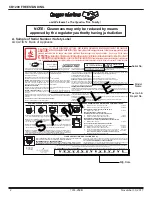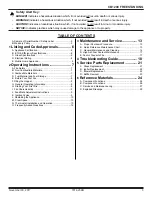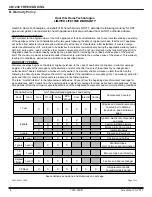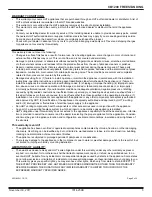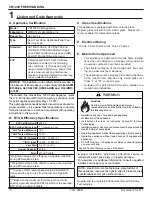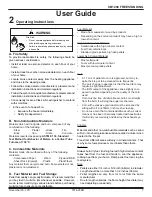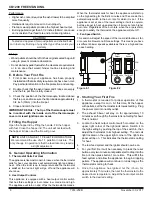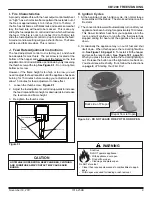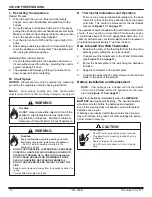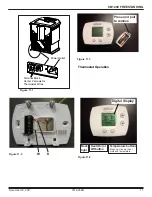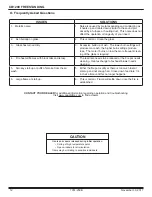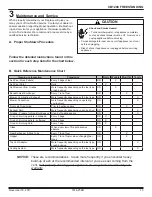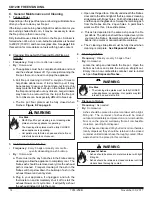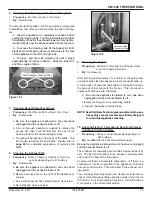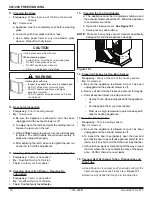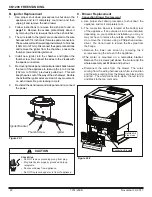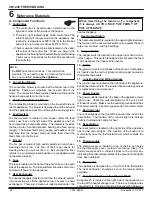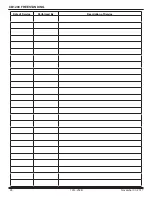
16
7014-259B
November 30, 2017
CB1200 FREESTANDING
11.
Cleaning the Glass
• Frequency:
When clear view of the fire pot becomes
obscure
• By:
Homeowner
a. Appliance must be completely cool before cleaning
glass.
b. Vacuum fly ash from glass and door rope.
c. Use a damp paper towel or any non-abrasive glass
cleaner. Wipe off with dry towel.
Handle glass assembly with care.
When cleaning glass:
• Avoid striking, scratching or slamming glass.
• Do NOT clean glass when hot.
•
Do NOT use abrasive cleaners.
• Refer to maintenance instructions.
CAUTION
Handle glass with care.
• Inspect the gasket to ensure it is undamaged.
• Do NOT strike, slam or scratch glass.
• Do NOT operate appliance with glass
assembly removed.
• Do NOT operate with glass cracked, broken
or scratched.
WARNING
12. Door Latch Inspection
• Frequency:
Prior to heating season
• By:
Homeowner
a. Be sure the appliance is allowed to cool, has been
unplugged and the exhaust blower is off
b.
To adjust, open the latch and pivot the holding rod out.
Loosen the jam nut on the rod.
c.
With a Phillips head screw
driver, turn the rod clockwise
to tighten. The latch handle should snap securely in
place when adjusted properly.
d.
After adjusting the latch, be sure to tighten the
jam nut
on the rod to hold the adjustment.
13.
Cleaning Exhaust Blower - Requires No Lubrication
• Frequency:
Yearly or as needed
• By:
Qualified Service Technician
• Task:
Contact your local dealer
14.
Cleaning Convection Blower - Requires No
Lubrication
• Frequency:
Yearly or as needed
• By:
Qualified Service Technician
• Task: Contact your local dealer.
15.
Cleaning the Top Vent Adapter
a. The appliance must be in complete shutdown and
the exhaust blower should be off. Allow the appliance
to completely cool down.
b. Open the clean-out cover.
See Figure 16.1.
c. Sweep out any ash build-up.
NOTE:
There are heavy duty vacuum cleaners specifically
designed for solid fuel appliance cleaning.
Figure 16.1
16.
Preparing Firebox for Non-Burn Season
• Frequency:
Yearly at the end of the heating season
• By:
Homeowner
a. Be sure the appliance is allowed to cool, has been
unplugged and the exhaust blower is off.
b.
Remove all ash from the firebox and vacuum thoroughly.
c. Paint all exposed steel, including cast-iron.
•
Use the Touch-Up paint supplied with the appliance;
or;
• Purchase paint from your local dealer.
• Must use a high-temperature paint made specifi
-
cally for heating appliances.
17. Door Gasket Inspection
• Frequency:
Prior to heating season
• By:
Homeowner
a. Be sure the appliance is allowed to cool, has been
unplugged and the exhaust blower is off
b. To inspect the door rope (gasket), open the door and
see that the door rope extends approximately 1/8 inch
(3mm) to 3/16 inch (9.5mm) from the door rope channel.
c. It should show signs of compaction all the way around
the door where the rope contacts the face of the appli-
ance. Confirm there are no air leaks.
18.
Vacuum Heat Exchanger Tubes, Firebox Area and
Drop Tube
a.
Use a Shop Vac to vacuum any fly ash and soot from the
heat exchanger tubes and firebox area.
Figure 17.1
.
b. Remove any debris that may be in the drop tube.
Clean Out
Cover

